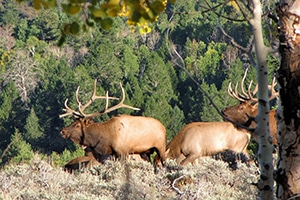MONTANA ELK HUNTING – AN EVOLVING STORY
In Montana elk hunting is a popular event and many anticipate it all year waiting for the season to arrive. This year certain hunting districts in Montana will be considered for a bonus shoulder season. With Montana Fish and Wildlife Commission still taking public comment on this topic, it has been stated that of the 138 elk-management areas in Montana, 80 are currently over objective, 30 are at objective and 19 are below objective. If a shoulder season is implemented it will aim to serve specific local circumstances in an attempt to bring elk populations closer to the objective as set in the State elk plan which was adopted in 1992 when the population of elk in Montana was approximately 90,000. In 2014, the estimated elk population in Montana was approximately 167,158 according to Montana FWP.
The story of the elk begins as they lived in abundance naturally across North America. With the arrival of the European settlers, elk numbers rapidly declined from over hunting. With the establishment of Yellowstone National Park in 1872, a large segment of land was set aside and protected, providing an emergence of elk recovery. In 1910, only 3,000 were thought to survive in all of Montana outside Yellowstone National Park. A concerted effort was initiated by citizen conservationist to restore elk populations. In 1910 the first elk transplant took place from Yellowstone National Park to Fleecer Mountain near Butte. This model expanded over the next three decades with the introduction of new elk herds into various areas in Montana. By the early 1940s the population was at an estimated 20,000 and steadily increasing. However, as numbers increased it began to take a toll on the land in these areas. Beginning in the late 1980s, in order to meet population objectives, Montana began adjusting hunting regulations with the establishment of elk management units, or EMUs. Another major impact on the elk herds was the reintroduction of wolves in 1995. This natural predator disrupted migratory patterns dispersing elk to areas of the State that have historically not harbored significant herds.
Today the elk population is once again all over the board and on the uptick in certain management districts. Conservationists are again trying to understand the big picture and manage the elk in particular areas across Montana.
One plan is to add a shoulder season to elk hunting. Elk are long lived and smart. A large segment of Montana’s elk population harbor on private land where the vegetation can be plentiful and the living is safer than on public land during hunting season. These large concentrations create a significant monetary impact on farmers and ranchers as herds eat resources used for domestic animals. Elk can also cause significant damage to fences, another large expenditure for private landowners.
A late shoulder season, although not the answer to everyone’s wishes, would allow more time for hunters to harvest elk as they move off of private lands. With the issue of the land matrix, pleasing hunters, pleasing private-land owners, and preserving a healthy elk population, there is a lot to be considered as the story continues.
For current information please visit Montana Fish, Wildlife and Parks at: http://fwp.mt.gov .

